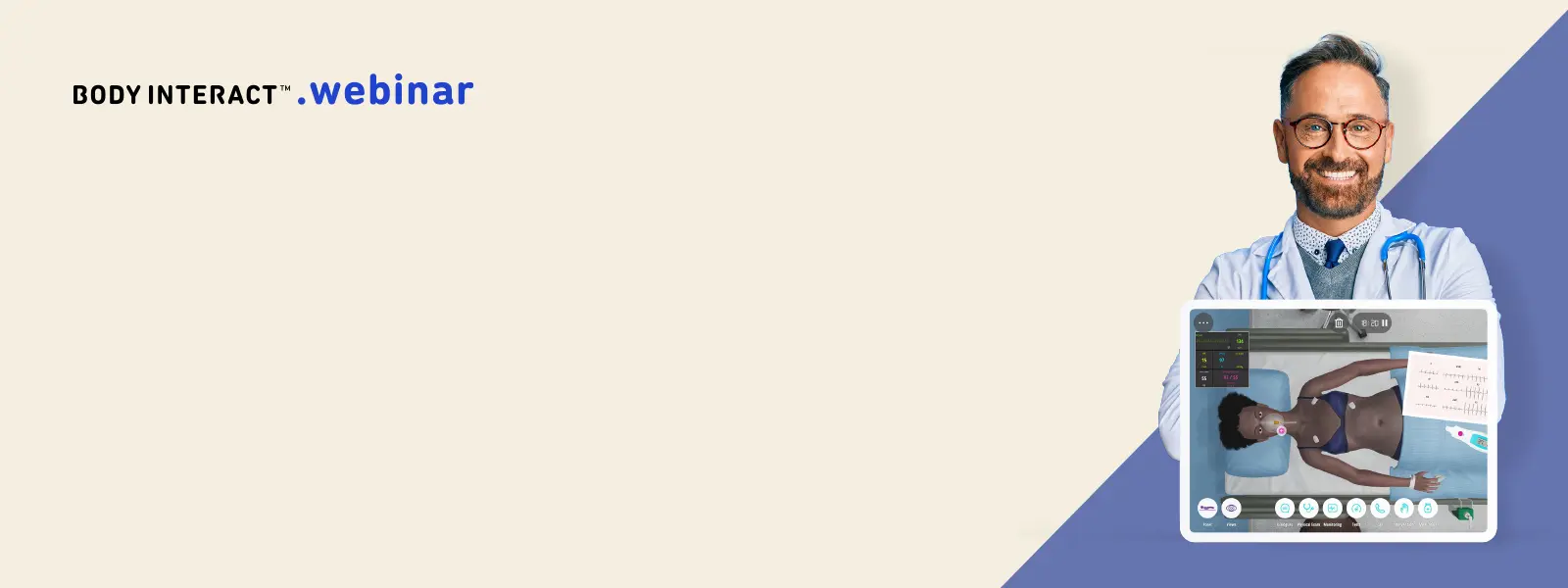If we look for the rationale for Accreditation by The World Federation for Medical Education, we will find that “certification is the suitability of medical education programs and of the competence of medical schools in the delivery of medical education”.
Healthcare professionals play a critical role in the lives of patients and consequently, their quality. Education is the key to providing the highest level of care and, for this reason, accreditation and certification represent an essential role. It ensures that students – future healthcare professionals – receive the demanded and requested training to become competent and confident healthcare providers.
Achieving accreditation of your simulation program
To better understand and promote the contribution of Virtual Patient Simulation to the Accreditation process of Schools and Universities simulation programs, Body Interact recently hosted a webinar under the same theme.
Maria Carolina Ferreira – Registered Nurse and team member of the Body Interact Training team – was one of the key speakers and shared with the audience an introduction regarding the definition and values of an accreditation process to a Medical and Nursing School/University. Dr. Edgar Herrera was our invited speaker. As a Healthcare Professional with 12 years of experience in simulation and President of the Mexican Society for Simulation in Health Sciences (SOMESICS), he explained the contributions and benefits of Virtual Patients over an accreditation process.
The Accreditation Process
The accreditation process typically involves a self-study of the program’s curriculum, followed by an external review by a team of experts who assess whether the program meets the required standards or not. Once a program has been accredited, it is subject to ongoing monitoring.
In this context, the use of simulation-based education has become an essential tool to provide high-quality training. Introducing Virtual Patients in the schools’ curriculum enables learners to practice clinical scenarios in a safe and controlled environment, providing them with an opportunity to learn from their mistakes and improve their performance
Over these challenges, Body Interact represents an effective tool to improve Knowledge, Skills, and Attitudes among current and future healthcare professionals. As a Virtual Patient Simulator, studies show that it promotes the integration of these three subjects relevant to the success and confidence of learners’ clinical practice.
Results of accreditation
Achieve objective evidence of improvement
Through the accreditation process, educators and all professionals of the institution can gain a deeper understanding of the role of simulation tools and strategies in healthcare education. As well as, its potential to enhance patient safety and outcomes.
The process requirements foster the institution to tailor their educational programs to meet the needs of individual learners and ensure that they are receiving the training they will need to excel in their current and future roles.
Opportunities for Sim instructors and students
For Sim instructors, accreditation demonstrates their expertise and competence in the field of simulation. It allows them to teach in various healthcare settings, including Hospitals, Medical Schools, and Simulation Centers.
For students, accreditation provides a means to distinguish themselves from their peers and demonstrate their competence to future employers. It provides them with access to a broader range of job opportunities in the healthcare industry, including clinical practice, research, and teaching. Learners will be better prepared to provide high-quality care to patients, resulting in better outcomes and ensuring patient safety.
National and international recognition
When achieved it demonstrates that the institution has met or exceeded the established standards for quality assurance, curriculum development, and educational outcomes. Thus, it not only promotes internal recognition but also international validation boosting the exchange of ideas, and reducing the linguistic barriers and other cultural differences that may have previously been raised between institutions.
By encouraging the connection and collaboration of Instructors, simulation experts, and organizations from around the world, the accreditation process also contributes to the exchange of best practices and the improvement of simulation education worldwide.
Body Interact contribution to the accreditation process
Dr. Herrera’s experience with Body Interact illustrates the benefits of Virtual Patient Simulation to the accreditation process. In 2016, his institution decided to look for Accreditation and Certification processes and seals for their simulation program and its trainers. The school began the accreditation process with Body Interact and due to the platform’s ease of use, familiarity, and immersive features, it turned out to be the “ideal choice”, highlighted the professor.
This achievement helped the institution grow internationally, demonstrating the program’s quality and effectiveness. Apart from the external recognition, it also contributed to the internal acknowledgment of the teachers’ expertise; constitutes a learners’ performance indicator, and lastly, promotes individual commitment and ongoing efforts to improve the skills and knowledge of both parties.
The year 2020 will always be remembered as a time of unprecedented global crisis. It forced educational institutions to close their doors and left many medical students in a difficult position, unable to continue their studies or gain clinical experience.
However, in Dr. Herrera’s opinion, amidst the chaos, a simulator stood out: Body Interact. An advanced simulation program that enabled medical students to continue their education online.
Combined with the University’s expertise and innovation, students were able to access a virtual hospital from the safety of their homes and everything without compromising the quality of their education. The program enabled students to participate in digital rotations and clinical virtual practice, ensuring that they gained the same level of experience as they would have in a real hospital.
Introduce high-quality simulation educational activities
Throughout the different challenges faced by the Institutions, the President of SOMESICS explained that “not only Body Interact enabled students to keep learning, but it also proved to be a valuable resource for educational institutions seeking accreditation”. With the program in place, institutions were able to ensure that their students received the same high-quality education as they would have received in pre-pandemic times, thus maintaining their accreditation status.

Consider exploring the accreditation options available for your institution and identifying the ones that are most relevant to your needs. Look for resources and tools that can help you prepare for this process.
Schedule a meeting with our team to learn more.
By Tomás Pereira – Marketing Trainee

& Rita Flores – Marketing Manager








